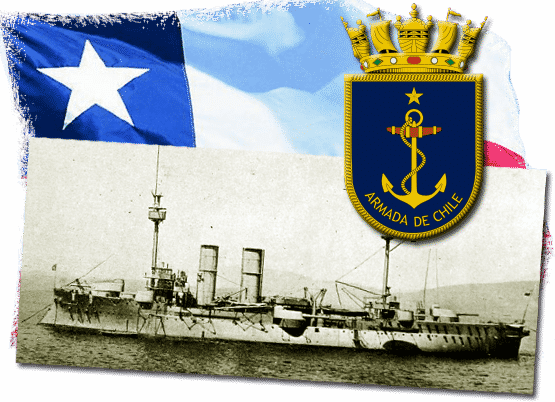 Armada de Chile – c150 ships 1939-45
Armada de Chile – c150 ships 1939-45The Chilean Navy in the interwar
Chile had a fruitful and ancient maritime history, shrouded in its past triumphs that left it at least until 1914 an aura of invincibility. Its clashes against Peru in particular, repeated victories in the Pacific in 1879-1883, and successful intervention in the revolution of 1891, had welded the Chilean population behind the navy. In 1914, Chile remained neutral but was considered to be the continent’s largest fleet. Strict discipline, technology and naval tactics were modelled on that of the Royal Navy, of which she was both the student and the most loyal customer, notably through a permanent British naval mission established since 1923.
The Chilean Navy after the Great war
Before even WW1, Chile was engaged in a vivid naval arms race, from 1887 to 1902 against Argentina. Chile by that time dominated the pacific and had grand plans of extension. Chile even had a reputation of invincibility due to its stunning victories in the Pacific and during the revolution of 1891. Not only it was recoignised as a first class fighting force, but also prestigious and highly respected at home, with popular support.
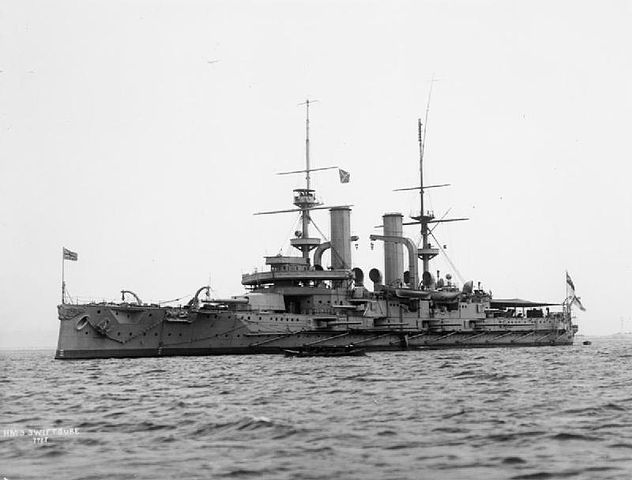
Chile ordered in 1901 the Constitucion and Libertad, but both were requisitioned by the Royal Navy in 1903
The Pacts of May 1902 ended the new naval race with Argentina (between the two countries, as it was revived between Brazil and Argentina for dreadnoughts in 1905). But Chile had problems with ordering battleships in British yards, and at first the pre-dreadnought Constitucion and Libertad were taken over by the Royal Navy in 1901, facing the rise of the Hochseeflotte (renamed HMS Swiftsure and Triumph).
The same scenario was repeated for the powerful dreadnoughts of the Latorre class, this time because the war broke out. Chile would eventually get its first dreadnought in 1920 but the prestige of the Navy will quickly dwindle down during the interwar.
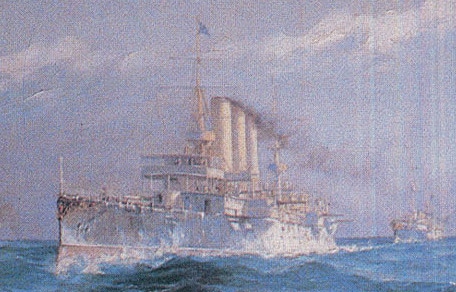
Chilean Cruiser o’Higgins
Chile during WW1
As a rather large regional naval power in 1914, the Armada de Chile was the third in tonnage on the entire continent, behind Argentina and Brazil. The second naval rivalry started after Brazil ordered the two Minas Gerais. Argentina replicated with the two Rivadvia, and Chili did ordered two dreadnoughts in 1911, too late for these to be delivered before the war broke out.
They were built by the Armstrong yards under the first provisional name of Libertad and Santiago, and later Almirante Latorre and Almirante Cochrane.
Their planned launch was 1914, meaning that both units were requisitioned in the course of completion and while the first was launched in 1915 under the new name of HMS Canada and sent to the fourth squadron, Almirante Cochrane was completed as an aircraft carrier in 1920 under the name of HMS Eagle.
The first was eventually returned to the Chilean Government in 1920, while the second was to be repurchased as well, but the yard gave a reconversion price way too steep for this to be realized. She was kept in service in the Royal Navy and fought in WW2.

The depot ship Araucano in 1941 (src: Conways)
Chile’s British built cruisers were its real strength, but there was the exception of the “young school” thought-out Capitan Prat, built in France in 1890. Two cruisers, Presidente Errazuriz and Presidente Pinto were also part of the contract.
There were extra destroyers built at the White shipyards (Almirante Lynch; Williams just prior to the war and also requisitioned (Faulknor class flotilla leaders). Chile would acquire its first submarines in 1917, six American-built Class H transferred.
Formation of the Chilean naval officers and doctrine was modelled on the Royal Navy for quite a long time. The naval college of Valparaiso was created by a council of British advisers in 1911.
Chile stayed neutral during the great war, even during the Battle of Coronel.
Chile was in line with other American states and because of several factors, the Chilean fleet relative weakness, a certain “benevolence” towards local German communities and their considerable investments plus, raw model of the Chilean Army, and the political weight of German immigrants. The Chilean shipping fleet was 87 steamers, 33 sailboats strong.
Von Spee’s squadron was able to supply in Chilean ports, some ships taking refuge there after the squadron was nearly obliterated. German Merchant ships were interned however and after the hostilities ended in November 1918, some of these ships were scuttled.
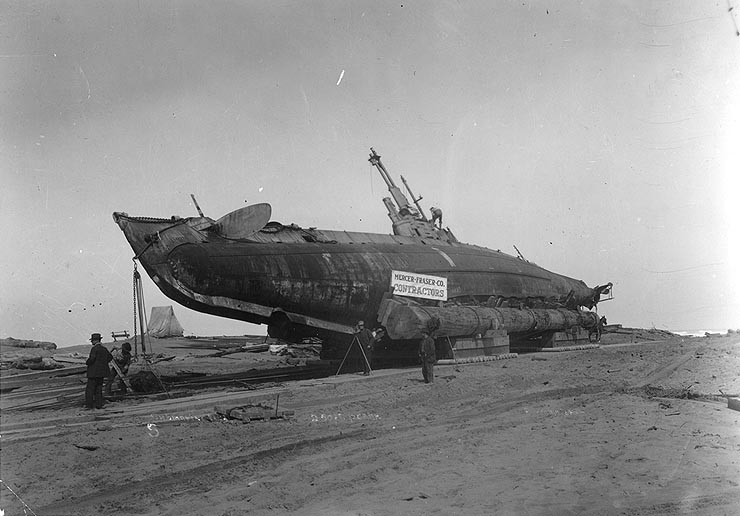
Submarine H3 stranded in 1917
Third naval force of South America, but in the background in 1914, Chile had a much smaller force in 1939. Ordering dreadnoughts a little later than the others, was supposed to give him a clear advantage over neighbors and rivals. However, in 1914, the construction of these two battleships was taken over by the Royal Navy, requisitioned, renamed, the first one participating in the operations of the Grand Fleet.
The Chilean capital ship: Almirante Latorre
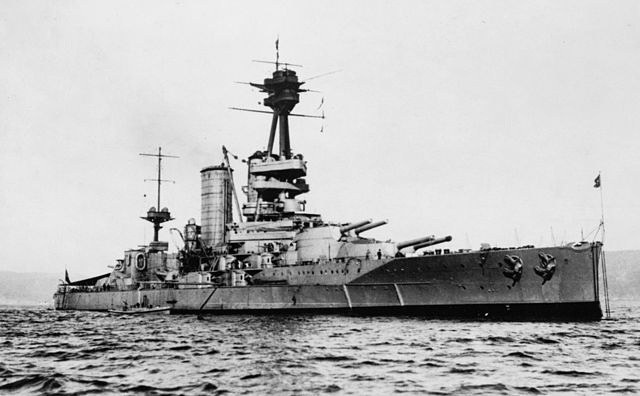
Dreadnought Almirante Latorre doing her sea trials in 1921.
Still modest in 1914, the Armada de Chile was third in tonnage in South America, behind Argentina and Brazil. These two fleets launched in the construction of Dreadnought very early on, Argentina having the two Rivadvia, and Brazil the two Minas Gerais. Chili did order too two dreadnoughts battleships in 1911, but did not receive these until 1920. In fact both dreadnoughts (really powerful even in British standards) were built at the Armstrong yards under the name of Libertad and Santiago, and then Almirante Latorre and Almirante Cochrane.
They were started in 1911 and 1913 with their planned launch in 1913-14, meaning that both units were requisitioned by the Royal Navy in the course of completion. The Almirante Latorre was launched in 1915 under the name of HMS Canada and was sent to the fourth squadron, notably fighting in Jutland. Almirante Cochrane was, however completed as an aircraft carrier in 1920 under the name of HMS Eagle. The first was eventually donated to the Chilean Government in 1920, while the second, which Chile wanted to rebuilt as a battleship, was kept in service in the RN and eventually sunk in 1942 by U73 in the Mediterranean.
After the war, HMS Canada returned to its original sponsors, under the original name of Almirante Latorre, while the other, unfinished as a battleship, was converted into an aircraft carrier and became operational with the Royal Navy under the name of HMS Eagle. Modernized in Britain, the Latorre was quite at the level of the Royal Navy’s other battleships and an impressive unit in 1939. Shortly after Pearl Harbor, the White House attempted to buy or rent the Latorre in Chile, and its other major units, to fill the gaping holes left in the Pacific fleet after the Nippon raid, but of course Chile, scalded by the British requisition of 1914, firmly refused.
Chilean Cruisers

Chilean Cruiser o’Higgins. In 1939 she was in reduced service, barely modernized.
In addition, the formation of the crews and the Chilean naval doctrine was entirely modeled on the tactical principles of the Royal Navy for a long time, notably since the founding of the naval college of Valparaiso, by a consortium of British advisers since 1911. Despite this acquaintance with London, Chile Like the rest of the American continent stayed neutral in August 1914, even so when the Germans and the British clashed in Coronel’s waters.
Interwar naval plans in Chile
A considerable financial effort had been made to maintain the navy’s rank in South America. The three antediluvian cruisers Blanco Encalada, Chacabuco and O’Higgins, still very popular, were in active service and kept in the front line, although not receiving any significant modernization. The rest of these forces were completed by destroyers aged from 10 to 30 years, and submersibles of the same generation. In 1927, the naval plan adopted made it possible to send the Latorre to Great Britain for modernization assorted of 6 destroyers (Thornycroft) 3 submersibles and a depot ship plus two oilers at Vickers-Armstrong.
By 1918, the British government offered to compensate Chile for the ships sent to build and used in the conflict, offering to deliver in compensation five new H-type submarines, interned in shipyards in the US because of neutrality. A batch of aircraft was offered and was purchased a sixth submarine while this extra aviation went to the Navy and Army.
Battleship “Almirante Latorre”, just reclaimed by Chile by February 20, 1921, became its naval ambassador, after moderniation and some active service in the Royal Navy. It had been a deterrent element for Chile’s international relations during its 30 years of service. Chile became also the only country, apart from great naval powers of the time, to acquire a battleship after the first World War. The souvernir of the South-Am naval arms race was long buried, as the economies of these countries, struck hard by WWI effect. Almirante Latorre was also the largest capital ship siuth of the Rio Grande, with largest displacement and largest caliber main battery, and that was true of any Spanish-speaking nation, including Spain and its 1912 dreadnoughts.

Conway’s Profile of the Esmeralda, decommissioned and scrapped in 1930.
Due to her arrival the government was forced to finance the construction of a second, larger dry dock in Talcahuano, expand workshops as well. Her weapons and propulsion systems constituted a school for the generations of sailors who passed through her decks. She also trigerred the creation of specialty schools, generating R&D branchs and teachers. Post-World War I compensations saw Chile having a boost in modern assets, notably the submarine force and Naval Aviation, and the country became its pioneer in South America.
In the 1920s, Latorre was modernized in the United Kingdom (fire control systems) also receiving modern 4-inch anti-aircraft guns, while its boilers were converted to burn oil instead of coal, which rose her range, in addition bulged for ASW protection, a brand new auxiliary machinery (modern diesels) to still defend herself at anchor, and a mordern communications suite. Back in mid-1931, her displacement rose to 32,000 tons, still above the Argentinian Rivadavia or Brazilian Minas Gerais classes. She can outrange her opponent with ease, notably bacuse of this modernization, which her oponents did not enjoyed.
To escort this capital ship and modernize the sole active squadron of the fleet, six destroyers of the “Serrano” class were ordere in the United Kingdom, plus three “O” class submarines and a submarine depot ship for them, all acquired as well as two oil tankers, rounding up an exceptional order, ensuring the Chilean Navy stays relevant for a decade, just after the 1929 financial crisis.
The 1931 Mutiny and economic deterioration

Bombing of Coquimbo in 1931.
In 1931, however, this fleet, which was numerically important, was widely criticized, it was a durable crisis that was forced to work in the various armed forces of Chili (sea, land and air), gangrened by officers meddling with politic affairs and a political opinion unambiguously opposed to the government in place, supported by the air and land arm branches, while the Navy remained loyalist.
In September 1931, a mutiny led by its own officers erupted in the Squadron, born in training ships at the Talcahuano naval base, later expanded to the Quintero air base (Air Force). The “Squad Uprising” was in protest against a significant reduction in salaries in a serious economic context. The Army defeated the mutineers on the ground, while the Air Force attacked the 22 planes Squadron in Talcahuano with bombs. Days later the movement was ended. As a result of this episode, a waltz of dismissals and replacements of felonious officers made the fleet loyal to the new government, but the episode left deep traces in public opinion, which began to detach itself from it. His prestige among the people had indeed been seriously undermined.
Chile was still in a difficult economic situation resulting in a decline due to rapid deterioration, lack of maintenance, and of skills as it was seen too costly to even purchase ammunitions and oil. Many ships were forced-decommissioned and by 1940, with Squadron was reduced to a core composed of the battleship “Latorre” and its attached Serrano class destroyers division.
Gallery:
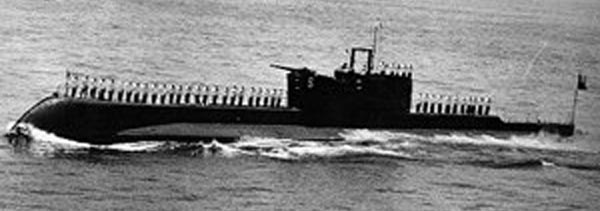
Chilean submarine Capitan O’Brien, date unknown, notice the black livery.
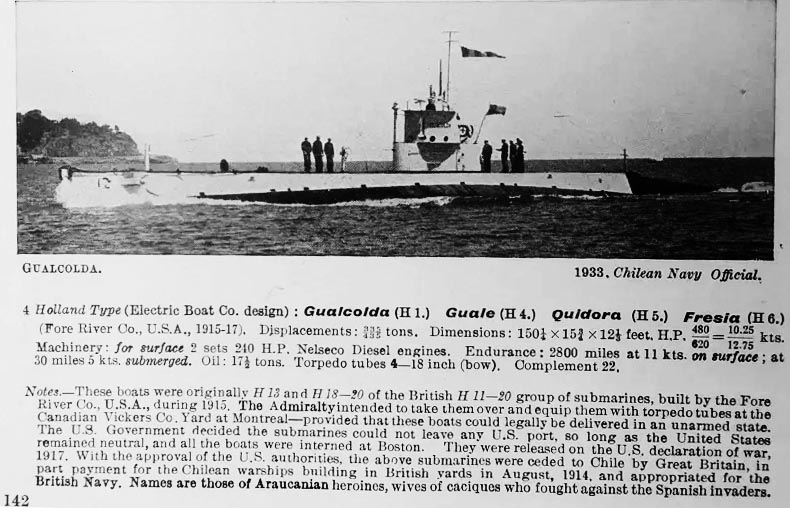
Chilean H-class submarines in Jane’s 1946 edition
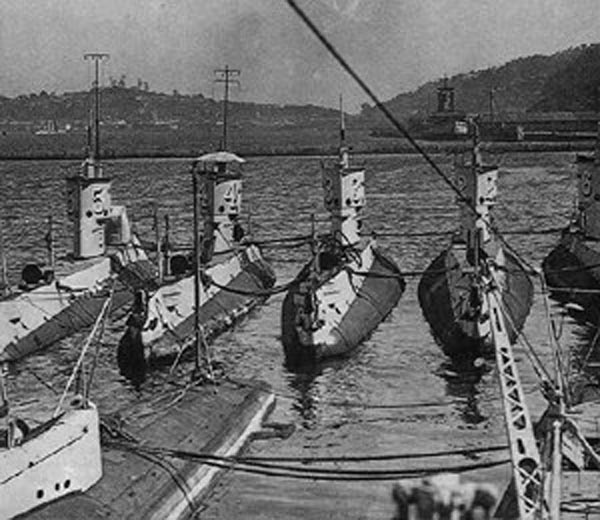
The squadron of Chilean H-class coastal submarines.
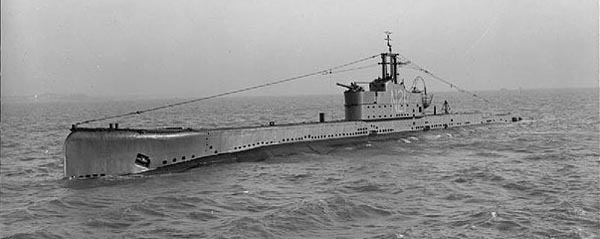
HMS Oberon, of the same type as the O’Brien
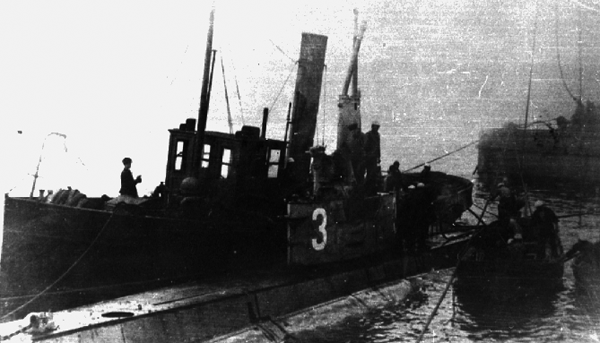
The submarine Rucumilla, one of the rare loyalist vessel in 1931
Chilean Order of Battle, 1940
During World War II, the Squadron carried out training and when war erupted between the US and Japan, the Chilean Navy started more torough patrol work, enforing its water’s nautrality and protecting its in and out trade lines.
Battleships: 1 – Cruisers: 3 – Destroyers: 8 – Submersibles: 9 – Misc.: 2
-Battleship Almirante Latorre. (1916, modernised 1929-31.)
-Cruiser Blanco Encalada (1893)
-Cruiser Chacabuco (1898)
-Cruiser O’Higgins (1899)
-Destroyers Class Almirante Lynch (1913, 2 ships)
-Destroyers Class Serrano (1928, 6 ships)
1944-45 transfers:
-Three Covadonga class frigates (River type, ex-Canadian transférées en 1944-45)
-Three Casma class Corvettes (type Flower, completed in Chile from Canada, 1945)
-Submersibles Fresia class (1915, costal)
-Submersibles Capitan O’Brien class (3 oceanic 1928)
-Schoolship Baquedano (1898)
-Submarine depot ship Araucano (1928)
After 1941, Chile remained neutral. In 1944, however, Britain, still hoping to see its student participate in the defense of convoys in the South Pacific, transferred three frigates to Canada through Canada. But Chile remained neutral until the capitulation of the Third Reich and it is now proven that this country was not hostile, far from it, like its Argentine rival, the old fugitives of the Third Reich.
In 1942, special legislation was enacte (the “Cruise Law”) for the renewal of the Armed Forces’ material. Regarding the Navy, its acquisitions were shifted from Europe to the United States. But it had to wait until after the war to be enacted. By 1945, a new round of acquisition were made, with the acquisition of ASW ships Canadian-built, three Rover class frigates and three Flower class corvettes, all re-equipped in the United States, arriving in 1946-1947.
But it’s in 1952, with the acquisition of two Brooklyn Class light cruisers from the United States, that the fleet could get rid of its antiquated battleship and shift to a two-squadron navy, an important technological advance with state of the art radar-assisted fire control systems with mechanical analog computers and electronic warfare surveillance and fire control. It was followed by further acquisitions, which will be detailed in the cold war chilean navy article, in writing.
Ships details
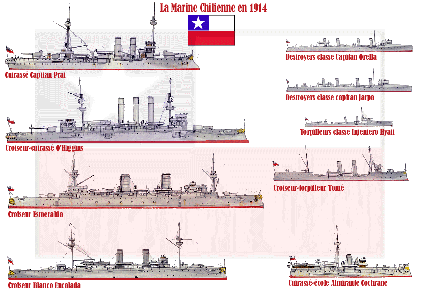
Chilean Navy in 1939-45 overview
Almirante Latorre (1921)
Latorre From reddit drydockporn – 1931 drydock in Britain, showing the ASW bulges.
> See the article
Ordered before the war but requisitoned and used as HMS Canada (also veteran of the battle of Jutland), she was retroceded to Chile in 1920 after a short refit. Almirante Latorre made her trials in 1921 and was commissioned.
Nomenclature of Chilean warships of WW2
 Dreadnought battleship Almirante Latorre (1915)
Dreadnought battleship Almirante Latorre (1915)
The Almirante Latorre, ex-HMS Canada-, was re-purchased by Chile after she was decommissioned in April 1920, along with four destroyer already ordered and requisitioned. The new flagship of the Chilean Navy was a concern indeed for Argentina, with Rivadvia class battleships’s main artillery was outclassed. To regain parity, Chile wanted the second battleship back, even in its converted state as HMS Eagle. Of course the cost of the reconversion was way too steep.
In 1927, there were grand plans for the navy: Three submarines and a depot ship, plus six destroyers were ordered to Vickers-Armstrong. Later, as part of a partnership contract with the Royal Navy, the battleship was sent for a modernization at Devonport in 1929. Her bridge was rebuilt, fire control system entirely modernized and extended to manage secondary artillery.
The steam turbine were replaced by new models, as the boilers, now all oil-firing models. Also, a new mast was placed in between third and fourth turret and anti-torpedo bulges were fitted. Also a modern anti-aircraft battery was installed. After two years, the battleship returned home, reaching Valparaíso on 5 March 1931, receiving son after an aircraft catapult.
The same year, like the rest of the Armada de Chile, Almirante Latorre took part in the great mutiny of the fleet. She was near-missed. After mutineers asked for a truce, the battleship headed to the Bay of Tongoy with Blanco Encalada. There, the army and navy loyalists took over the ships, and all were jailed, while the leaders were later shot by execution squads.
Compounded by the bad reputation of the Armada, the 1933 economic depression prevented any modernization before the war started. Budget cuts were so severe as to sent the Latorre at Talcahuano to be deactivated and the crews rendered to civilian life. In 1937 however, the catapult was dismounted and extra AA installed.
In 1942, after the failed proposal of the USN to purchase her, she was reactivated and participated in neutrality patrols until the end of the war. After a boiler accident in 1951 she was never repaired and mothballed instead, deactivated and decommissioned in 1958 and BU in 1959.
Characteristics (1940):
Dimensions: 181.3 x 29.30 x 8.4m (594 x 98 x 27 ft)
Displacement: 28,600 t, 32,120 t FL
Crew: 834
Propulsion: 4 shafts Brown-Curtis & Parsons turbines, 21 Yarrow Boilers, 37,000 hp
Speed: 22.75 knots (42.13 km/h; 26.18 mph)
Range: 10,000 km at 10 knots
Armament: 10 x 356mm/50 (14in) (5×2), 16 x 152mm/50 (6in), 2x76mm AA (3in), 4x47mm (1.9in) saluting, 2x533mm TTs (21in).
Armor: Belt: 9in (230mm), deck 1.5in (38mm), turrets, barbettes 10in (254mm), CT 11-in (280mm)
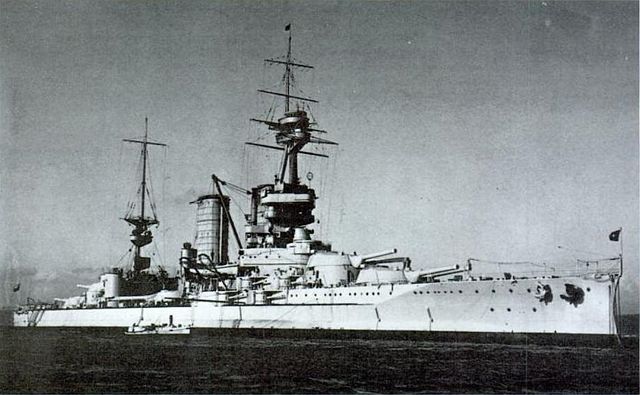
Battleship Almirante Latorre in the 1930s
 Chilean cruisers: Blanco Encalada, Chacabuco and O’Higgins
Chilean cruisers: Blanco Encalada, Chacabuco and O’Higgins
In 1939, only one old cruiser remaining of the nine ordered in the 1880-90s to British yards: The modernized Chacabuco. The last three, still listed in 1939, were the Blanco Encalada, Chacabuco and O’Higgins. They dated back respectively from 1893, 1898 and 1899. In WW1 they were still up to date, but during the interwar, their military value gradually dwindled down not only in general military standards but also capabilities, whereas only Argentina ordered new ships.
Also other ships were discarded in the interwar: Presidente Errazuriz (in the 1920s), Ministro Zenteno (1931), and Esmeralda (1929). So from nine, Chile was down to just one obsolete cruiser during WW2.
Blanco Encalada:
In 1906, she was involved in the brutal repression of miners strikes in Antofagasta, Iquique, and its troops butchered the population at the Santa Maria de Iquique school.
In 1920, she was converted into a training ship and only retained five 76mm guns and a 40 mm anti-aircraft gun while the main and secondary artillery and torpedo tubes were dismantled.
In the 1930s she was placed on reserve and used as a floating shop and depot, sold and scrapped in 1946. Therefore she was in no condition to participate in any wartime operations during WW2.
Chacabuco
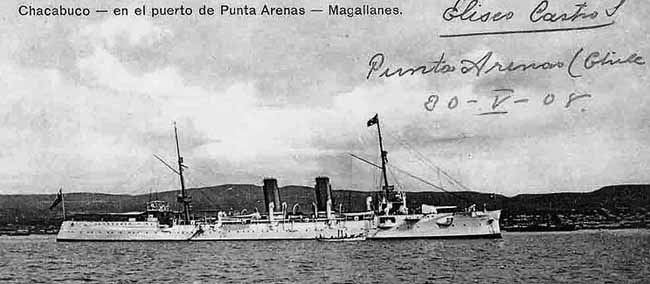
Chacabuco in 1908
Chacabuco performed during her career patrols but also hydrographic duties. She was deployed for to maintain order after 1906 Valparaíso earthquake and also her troops took part in the infamous Santa María School massacre in 1907. She represented Chile at the King George V in 1911 coronation review, and bring relief to the victims of the 1922 Vallenar earthquake. She was quite old and joined the reserve in 1928.
In 1941, she was brought out of reserve and crewed, as the last available Chilean cruiser, and reported for duty. Before taking out for any mission she was modernized, receiving six 6-in/50 guns and ten 20 mm Oerlikon AA guns. She replaced the Latorre as Chilean Navy flagships in some occasions. The war ended, and in 1949, due to her good maintenance and modern armament, she became an active midshipmen training cruiser until 1950. She was sold for BU afterwards, after being stricken on 15 December 1959. She was scrapped by the Compañía de Acero del Pacífico.
Characteristics (1942):
Displacement: 4,160 long tons (4,230 t) FL
Dimensions: 109.7 x 14.2 x 5.2 m (360 ft x 46 ft 6 in x 17 ft)
Propulsion: 2 shaft VTE, 4 cyl. boilers 15,700 hp, 23 knots (43 km/h; 26 mph)
Armour: Deck: 1.75–4.5 in (44–114 mm), main gun shields 4.5 in (114 mm), CT 3 in (76 mm)
Crew: 400
Armament: 6 x 6-inch/50 guns, ten 20 mm AA guns Oerlikon.
O’Higgins
After testing a floatplane in 1920 she resumed exercises, only to collided in March 1920 with the Chilean cargo SS Llai Llai in Philadelphia. The cargo sank, as the shock came from the cruiser’s bow. Also on 24 August 1920, an aircraft crashed into her. Repaired, she has been refitted in 1919–1920 and will be refitted again in 1928–29. In 1931, she was involved in the Chilean fleet mutiny, controlled by her crew on 1 September 1931.
The mutiny was a result of wage reductions decreed by the government in the wake of the Great Depression. O’Higgins like the rest of the mutineers was bombarded by the Chilean air force, and only near-missed during this attack. The mutiny ended and she returned to normal service, remaining the flagship of its fleet. She was decommissioned in 1933 however. From then on she became a depot ship, and then a hulk, eventually scrapped in 1958.
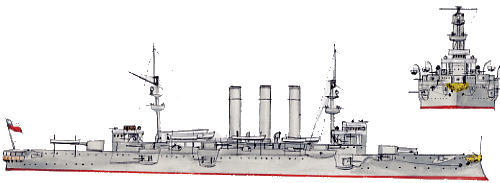
O’Higgins in the 1920s.
Chilean destroyers during WW2
Eight destroyers composed the strike force of the Chilean Navy, but in 1933, they were eleven. It should be noted that the interwar saw seven older TBs discarded in 1924: The four Capitan Orella and the two Capitano Merino Jarpa class and sole Capitan Thomson.
 Almirante Lynch class (1913)
Almirante Lynch class (1913)
Almirante Lynch, Almirante Condell
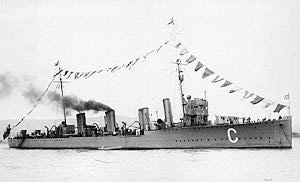
These destroyers were part of initially a larger class of six vessels. They were ordered from J. Samuel White in 1911. These were not derived from existing ships in the RN pbut rather a specifically private venture design by J. Samuel White. He proposed to the Chileans a destroyer than would have a significant advantage over other standard destroyers in the Pacific, as they were significantly larger and heavier armed. Their silhouette was characteristic with four funnels showing a tall and narrow fore funnel plus three equally spaced broader and shorter ones.
The Yard previously never built such large destroyers and the Chilean order obliged the White Yard to expand its basins and purchase of a 80 ton hammerhead crane from Babcock & Wilcox.
As designed, the Chilean destroyers carried six single QF 4 inch guns, with two pairs on the forecastle, in front and abreast of the wheelhouse and the remaining pair on the quarterdeck. These guns were of the bran new Elswick design, also tailored for the Chileans, however after requisition, standard British guns replaced them. In 1918, the British replaced this artillery a BL 4.7 inch on the forecastle and placed another on a bandstand placed between the after pair of funnels. The two 4 inch guns abreast the wheelhouse were kept but two QF 2-pdr AA were added.
Launch dates in brackets- The class comprised the Almirante Lynch (1912), Almirante Condell (1913), Almirante Simpson (1914), Almirante Uribe (1914), Almirante Williams (1914) and Almirante Riveros (1915). Only the first two were delivered to Chile, as completed in 1913 and January 1914. The others were requisitioned (see below).
 Almirante Williams class destroyer (1914) – Acquired 1920
Almirante Williams class destroyer (1914) – Acquired 1920
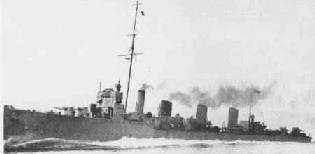
Before that date, those three ships to be discarded were William White designs dating back from 1912, the Almirante Rebodello, Coni and Simpson. These were 1800 tonnes, four funnelled ships reminiscent of the Faulknor class flotilla leaders.
They were requisitioned in 1914 and completed for the Royal Navy as HMS Botha, Broke and Faulknor and their design had follows up. They served with distinction in WW1, originally four ship, the fourth being named HMS Tipperary, sank at Jutland in 1916. The other survived the war and were put on the disposal list in 1919, to be repurchased by Chile. They took the name of Almirante Williams, Uribe and Riveros and served until 1933. There are no clear reasons given but for economical ones for them to be discarded.
Characteristics:
Displacement: 1,090 long tons standard, 1,430 long tons fully load
Dimnsions: 91.44 m (300 ft) oa x 8.84 m (29 ft) x 3.86 m (12 ft 8 in)
Propulsion: 2 shafts Parsons-type geared steam turbines, 3 Thornycroft boilers 28,000 shp (20,880 kW)
Top Speed: 35 kn (65 km/h; 40 mph)
Complement: 130
Armament: 3 × 4.7 in (120 mm)/45, 1 × 3 in (76 mm)/40 AA, 6 × 21 in (533 mm) TTs
 Serrano class destroyer (1928)
Serrano class destroyer (1928)
Serrano, Hyatt, Orella, Riquelme, Videla, Aldea
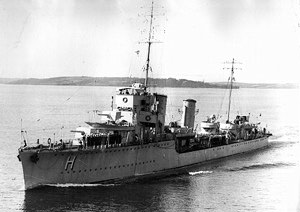
The Serrano-class destroyers of the Chilean Navy were ordered in 1927, built in 1928-29 at Thornycroft, all. They will served until 1967. Like Serrano and Orella, Hyatt was also equipped with minelaying. Their armament was limited to three 4.7 in (120 mm)/45 and one 3 in (76 mm)/40 DP gun, two triple 21-inch torpedo tubes banks. Smaller than regular British destroyers of the time, they still were capable of 35 knots (65 km/h; 40 mph) as designed, but much better in trials. Their armament was placed in superfiring positions, with the omitted deck gun aft. The Bofors AA was placed like in British ships in between the funnels on a raised platform. They were tailored to serve on all climates. However it appeared overall that their light construction was not appropriate for the heavy weather of the southern waters off Chile.
Characteristics:
Displacement: 1,090 long tons standard, 1,430 long tons fully load
Dimensions: 91.44 m (300 ft) oa x 8.84 m (29 ft) x 3.86 m (12 ft 8 in)
Propulsion: 2 shafts Parsons-type geared steam turbines, 3 Thornycroft boilers 28,000 shp (20,880 kW)
Top Speed: 35 kn (65 km/h; 40 mph)
Complement: 130
Armament: 3 × 4.7 in (120 mm)/45, 1 × 3 in (76 mm)/40 AA, 6 × 21 in (533 mm) TTs
 Fresia class submarines (1917)
Fresia class submarines (1917)
Fresia, Guacolda, Guala, Quidora, Rucumilla, Tegualda
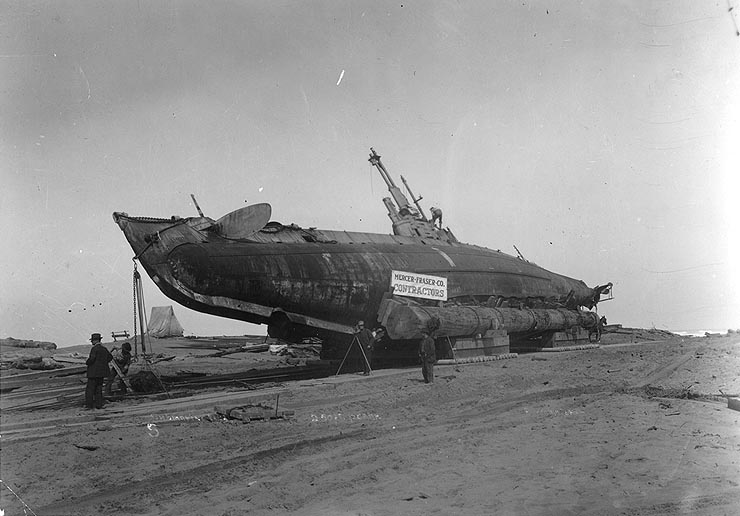
Six US-built H3 class submarines which had a complicated history. Twenty has been ordered to UK in 1914, at first built in the USA, unarmed, with the hope to arm them in Canada and send them to UK for an official deliver. However the US, for protecting their firm neutrality sense, interned them at Boston until they entered war themselves.
They were released, but meanwhile the UK accepted to ceded five boats to Chile as payment for the expropriated battleship Canada and destroyers.
Chile purchased one of the American boats in addition. Official acquisition took place on 7 July 1917. They kept their H denomination until 1936 and were renamed. One sank during exercises in 1927 with all hands, but was refloated and returned into service again.
Small, 33 meters long for 364 tonnes, they were considered coastal subs in 1941, used to patrol home waters during WW2. Three were discarded in 1945, the others in 1949-53.

H-class submarines
Characteristics (1940):
Displacement: 364 tons standard, 435 tons underwater
Dimensions: 33.5 x 4.8 x 3.7m
Propulsion: 2 shafts Nelesco diesels, electric motors, 480/640 bhp, 13/5 knots, range 2800 nm/11 knots.
Crew: As British H class
Armament: As British H class
 Capitan O’Brien class submarines (1928)
Capitan O’Brien class submarines (1928)

Author’s rendition of the Capitan O’Brien
Almirante Simpson, Capitan O’Brien, Capitan Thompson
Three modern Vickers-Armstrong Oberon/Odin (‘O’) type submarines. Launched 1928-29, they had been modified for Chilean service before delivery and were smaller. Their famous trademark was the 4.7 in gun in the “bath-tub” of the large forward conning tower.
They entered in service in the Armada in May to September 1929. With their 2020 tonnes displacement when underwater, they were considered as oceanic, long patrol types. They served for long range patrols during WW2 on the pacific coast, and were deactivated and discarded in 1957-58, without noticeable events.
Characteristics (1940):
Displacement: 1540 tons standard, 2020 tons underwater
Dimensions: 79.25 (pp) x 8.53 x 4.15m (260 x 28 x 13 ft 6 in)
Propulsion: 2 shafts diesels, electric motors, 2750/1300 bhp, 15/9 knots, range 9000 nm/11 knots.
Crew: 54
Armament: 8 x 21-in TT (533 mm, 6 bow, 2 stern), 1 x 4.7 in guns (114 mm)
 Miscellaneous ships
Miscellaneous ships
Araucano (1929)
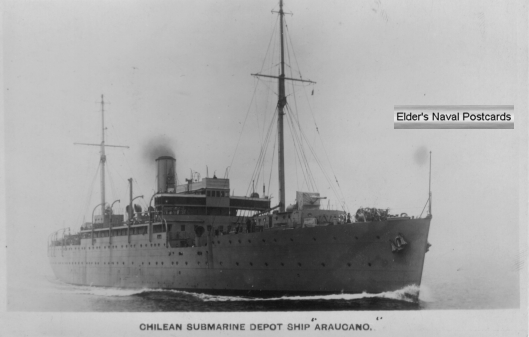
Araucano – Postcard
To go with the new ordered submarines, and the coastal submarine fleet, the Chilean Navy ordered to UK a submarine depot ship with specifications: Her facilities included the use of the ship as a training vessel and command flagship of the fleet as well, carrying an observation and liaison seaplane. Built at Vickers-Arsmtrong, she was smaller than contemporary British depot ships, but still larger than most Chilean cruisers but Esmeralda, displacing 9,000 tons.
Her armament however, and speed, has northing to do with a cruiser. Araucano was armed with just two standard 4.7 in guns and five 20 mm light AA guns. She made a career without particular events and was discarded in 1958.
Characteristics (1940):
Displacement: 9000 tons standard, ? FL
Dimensions: 118.87 x 16.76 x 5.03m (390 x 55 x 16 ft 5 in)
Propulsion: 2 Parson steam turbines 2400 bhp, 13 knots
Armament: 2 x 4.7 in guns (114 mm), 5 x 20 mm AA
Elicura class minelayers (1917)
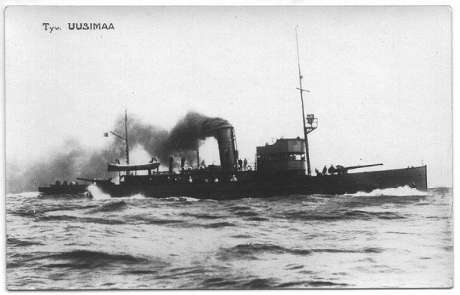
Colo Colo as Uusimaa
At the origin these were six dispatch ships built in Helsinki in 1917 for the Imperial Russian Navy. In 1918 they were captured by Finns while in construction on their slipways. They were named Chibis, Kulik, Strizh, Bekas. In 1919 they were sold, still incomplete by Finland to Chileas surplus.
In Chilean service they were renamed Colocolo, Elicura, Leucoton, and Orompello. Meanwile, the extant Golub and Pingvin were active with the Finnish navy, rated as gunboats, and renamed Uusimaa and Hämeenmaa. In 1920, the Chilean vessels passed through British White yard. They were re-equipped as minelayers and reached Valparaiso on 26-10-1920.
Their career seemed uneventful. During the 1931 mutiny, the Colo Colo was one of the mutineer ships. She chased the loyalist submarine Rucumilla (see above), which came to torpedo some ships in the fleet. The Colo Colo changed name and sank in 1944. The fate of the others is unknown. Not listed in Conways.
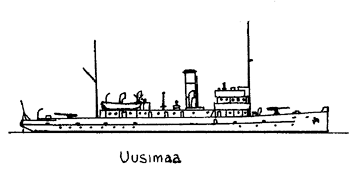
Profile of the Elicura class
Piloto Sibbald Patrol ship (1915)
This Patrol vessel was created to serve with the coast guard, and performed SAR as well. She was also designed as a fire fighting ship, and was equipped for salvage. Completed in 1916, she was requisitioned by the Royal Navy and used as HMS Stoic. The war ended and in 1920, as other ships, she was re-purchased by Chile.
The Piloto Sibbald displaced 1100 tonnes standard. Steel hull, two funnels, two masts, and flared utility stern like tugs. She measured 43.1 m by 8.69 m in width, 3.35 m in draft. She was propelled by two shafts VTE, fed by 2 cylindrical boilers. This machinery was rated for 1200 shp, top speed 11.5 knots. She carried 145 tonnes of coal and was armed with a single 37/20 mm Hotchkiss gun, crewed by 18.
Yalco Patrol ship (1909)
The Yelcho was ordered at George Brown yard of Greenock in 1906, launched in 1908. She displaced 280 tonnes standard for 467 FL, dimensions were 39.0 m x 7.01 m x 2.90 m. She was propelled by a single shaft VTE, 350 shp. She was able to reach 13 knots and carried 12 tons of fuel and was armed by a single 37/20 mm Hotchkiss gun. No notable events. Hulked in 1945.
General Baquedano training corvette (1898)
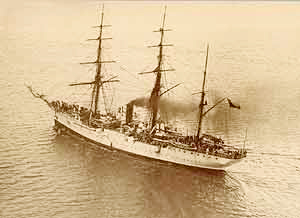
The mixed steam/sail school corvette of the Chilean Navy. She has been ordered specifically for this purpose at the Armstrong Whitworth yard. Launched on 5 July 1898, she was commissioned on 22 August 1899. She replaced the old Abtao and Pilcomayo.
She was refitted in Talcahuano 1922-1926 and continued to serve as training ship until 1935, was hulked then converted into other purposes until 1959. She displaced 2500 t, a composite steel hull vessel rigged as a barquentine, measuring 73.2 m x 5.5 m (240 x 18 ft).
She was propelled by a 1,500 HP steam engine fed by a single Belleville boiler. Top speed was 13.75 knots (25.47 km/h; 15.82 mph), the crew comprised 333 cadet sailors and officers.
Books
Conways all the worlds fighting ships 1906-1921 & 1922-47.
Encina – Castedo (1978). Historia de Chile. Santiago: Editorial Zig Zag.
Fuenzalida Bade, Rodrigo (1978). La Armada de Chile. Santiago: Editorial Aquí esta.
López Urrutia, Carlos (1969). Historia de la Marina de Chile. Santiago: Editorial Andrés Bello.
Tromben, Carlos – Jarpa, Sergio (1995). La Escuadra Nacional – 175 años. Santiago: Editorial Sipimex Limitada.
Links
https://www.armada.cl/
https://www.youtube.com/@armadachile
Tweets by Armada_Chile
https://www.mardechile.cl/wordpress/
https://web.archive.org/web/20131104131539/http://www.armada.cl/prontus_armada/site/edic/base/port/armada_ingles.html
https://www.biobiochile.cl/noticias/nacional/chile/2020/04/24/revelan-que-armada-pago-70-millones-de-dolares-a-australia-por-dos-fragatas-usadas.shtmlhttps://www.eldesconcierto.cl/nacional/2019/11/24/la-millonaria-y-polemica-compra-de-fragatas-de-la-armada-en-medio-del-estallido-social.html
https://www.infodefensa.com/texto-diario/mostrar/3127520/construccion-nuevo-rompehielos-chile-esta-20
https://web.archive.org/web/20210219133049/https://ww3.museodelamemoria.cl/Informate/arpillera-tortura-y-crimenes-en-la-esmeralda/
Centro de tortura flotante recalará mañana en Puerto Chacabuco
https://es.wikipedia.org/wiki/Armada_de_Chile


 Latest Facebook Entry -
Latest Facebook Entry -  X(Tweeter) Naval Encyclopedia's deck archive
X(Tweeter) Naval Encyclopedia's deck archive Instagram (@navalencyc)
Instagram (@navalencyc)





 French Navy
French Navy Royal Navy
Royal Navy Russian Navy
Russian Navy Armada Espanola
Armada Espanola Austrian Navy
Austrian Navy K.u.K. Kriegsmarine
K.u.K. Kriegsmarine Dansk Marine
Dansk Marine Nautiko Hellenon
Nautiko Hellenon Koninklije Marine 1870
Koninklije Marine 1870 Marinha do Brasil
Marinha do Brasil Osmanlı Donanması
Osmanlı Donanması Marina Do Peru
Marina Do Peru Marinha do Portugal
Marinha do Portugal Regia Marina 1870
Regia Marina 1870 Nihhon Kaigun 1870
Nihhon Kaigun 1870 Preußische Marine 1870
Preußische Marine 1870 Russkiy Flot 1870
Russkiy Flot 1870 Svenska marinen
Svenska marinen Søværnet
Søværnet Union Navy
Union Navy Confederate Navy
Confederate Navy Armada de Argentina
Armada de Argentina Imperial Chinese Navy
Imperial Chinese Navy Marinha do Portugal
Marinha do Portugal Mexico
Mexico Kaiserliche Marine
Kaiserliche Marine 1898 US Navy
1898 US Navy Sovietskiy Flot
Sovietskiy Flot Royal Canadian Navy
Royal Canadian Navy Royal Australian Navy
Royal Australian Navy RNZN Fleet
RNZN Fleet Chinese Navy 1937
Chinese Navy 1937 Kriegsmarine
Kriegsmarine Chilean Navy
Chilean Navy Danish Navy
Danish Navy Finnish Navy
Finnish Navy Hellenic Navy
Hellenic Navy Polish Navy
Polish Navy Romanian Navy
Romanian Navy Turkish Navy
Turkish Navy Royal Yugoslav Navy
Royal Yugoslav Navy Royal Thai Navy
Royal Thai Navy Minor Navies
Minor Navies Albania
Albania Austria
Austria Belgium
Belgium Columbia
Columbia Costa Rica
Costa Rica Cuba
Cuba Czechoslovakia
Czechoslovakia Dominican Republic
Dominican Republic Haiti
Haiti Hungary
Hungary Honduras
Honduras Estonia
Estonia Iceland
Iceland Eire
Eire Equador
Equador Iran
Iran Iraq
Iraq Latvia
Latvia Liberia
Liberia Lithuania
Lithuania Mandchukuo
Mandchukuo Morocco
Morocco Nicaragua
Nicaragua Persia
Persia San Salvador
San Salvador Sarawak
Sarawak Uruguay
Uruguay Venezuela
Venezuela Zanzibar
Zanzibar Warsaw Pact Navies
Warsaw Pact Navies Bulgaria
Bulgaria Hungary
Hungary

 Bundesmarine
Bundesmarine Dutch Navy
Dutch Navy Hellenic Navy
Hellenic Navy Marina Militare
Marina Militare Yugoslav Navy
Yugoslav Navy Chinese Navy
Chinese Navy Indian Navy
Indian Navy Indonesian Navy
Indonesian Navy JMSDF
JMSDF North Korean Navy
North Korean Navy Pakistani Navy
Pakistani Navy Philippines Navy
Philippines Navy ROKN
ROKN Rep. of Singapore Navy
Rep. of Singapore Navy Taiwanese Navy
Taiwanese Navy IDF Navy
IDF Navy Saudi Navy
Saudi Navy Royal New Zealand Navy
Royal New Zealand Navy Egyptian Navy
Egyptian Navy South African Navy
South African Navy






























 Ukrainian Navy
Ukrainian Navy dbodesign
dbodesign